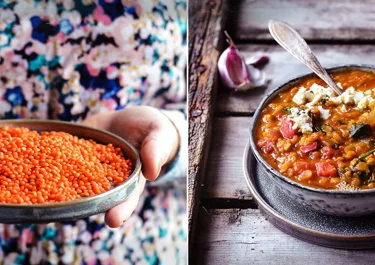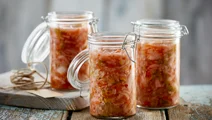Daal

Daal holds a cherished place in Indian kitchens because of its warm, comforting flavours. Our red lentil daal recipe combines smooth coconut milk with sweet dates and fresh spinach for a dish that warms the heart and delights the taste buds. Perfect for a cosy evening or a delicious family meal, this daal is set to become a treasured part of your recipe collection.
Ingredients
|
300 ml
Red lentils (about 260 g)
|
|
|---|---|
|
2
Large onions, chopped
|
|
|
4
Garlic cloves
|
|
|
2
Fresh red chillies
|
|
|
1 can
Tomatoes
|
|
|
100 g
Spinach leaves, fresh or frozen
|
|
|
6
Sun-dried dates, finely chopped
|
|
|
100 ml
Coconut milk
|
|
|
700 ml
Water
|
|
|
2 tsp
Ground cumin
|
|
|
1 tsp
Ground turmeric
|
|
|
½ tsp
Cinnamon
|
|
|
2 tbsp
Oil
|
|
|
2 tsp
Salt
|
To serve
|
Warm bread
|
|---|
Instructions
FAQ: Questions about daal
Do you want to know more about daal? Here, we have compiled answers to some of the most commonly asked questions about this dish. Let us dive right into it!
What is daal?
Daal is a term used in Indian cuisine to describe a variety of flavourful dishes made from split pulses such as lentils, peas, and beans. These dishes are typically seasoned with a rich blend of spices and can include other ingredients like onions, tomatoes, tamarind, or coconut. It is commonly enjoyed with rice or bread like roti or naan.
How should I store daal?
Daal should be allowed to cool completely before being stored in a sealed container in the refrigerator, where it can be kept for up to five days. If you need to store it for a longer period, freeze the daal in appropriate portions; it can remain frozen for up to six months.
How should I reheat daal?
To reheat daal, you can either use a stovetop or a microwave. For stovetop reheating, transfer the daal to a pot, add a little water if it appears too thick, and warm it over medium heat, stirring occasionally. In the microwave, place the daal in a microwave-safe container, loosely cover it, and heat it on high for several minutes, stirring halfway through to ensure even warming.
Do I need to soak lentils before cooking them?
You do not have to soak lentils, particularly red ones, as they cook fairly fast compared to other legumes. However, it is important to rinse them well to get rid of any dirt. If you are using other lentil types that benefit from soaking, like green or brown, do soak them as per the instructions to reduce cooking time.
Tips: Get the best daal
Want to know how to make the best daal possible? Then take a look at our tips below before you start preparing this recipe.
Rinsing lentils
Rinse your red lentils under cold water until clear to remove any natural debris. This ensures a clean, earthy taste. Soaking red lentils is optional as they cook fast, but it can help other varieties cook quicker. If you are using different lentils, adjust the cooking time to ensure perfect softness.
Select the right lentils
Look for red lentils that are even in size, spot-free, and vibrantly coloured. These are signs that they are fresh and will cook evenly, keeping their shape and giving your daal an appealing texture.
Adjust the texture
Once the daal has simmered and the lentils are soft, blend part of the mixture until smooth. Mix this creamy blend back into the pot before you add the coconut milk. This thickens the daal while keeping some whole lentils for texture. You will get a rich, creamy texture that still has bits of lentil to enjoy.
Make a delicious daal
Immerse yourself in the comforting embrace of delicious homemade daal. The dish remains a cornerstone of Indian cuisine, and now you can introduce it to your friends and family. It is known for its warm, slightly spicy taste and creamy consistency. We have added coconut milk to our daal and topped it with crumbled white cheese. Try it out and savour the delightful flavours of this Indian-inspired dish.
Tender red lentils with creamy coconut milk
Red lentils are a favourite choice for making daal due to their numerous appealing qualities. As they cook, they soften into an almost creamy consistency, seamlessly blending into the dish. These lentils are quick to prepare, becoming soft and smooth within half an hour. As they cook, they absorb the rich flavours of spices, sun-dried dates, and earthy spinach. To help with the creaminess, we have added a generous amount of coconut milk that boosts both the taste and texture of the daal.
Infused with a subtle sweetness from dates and warm spices
Rich, deep, and warm flavours meet a burst of sweetness in our recipe for daal. The sun-dried dates bring a subtle, natural sweetness that helps balance out the spices, creating a well-rounded flavour. The sweetness is never overpowering but rather mellow and delicate. This specific nuance of sweetness works wonderfully with turmeric, cumin, and cinnamon. Together, they form a warm, aromatic backbone with earthy, peppery, and sweet notes that help turn the daal into the comforting meal it is.
An Indian staple with many names
While we call it daal, others refer to the delicious dish as dal, dhal, or dahl. Do not worry; they are all the same. The name actually refers to dried, split lentils, but over time, it has also become a name for curry-like meals. It is a dish steeped in Indian tradition with roots extending far back in time. Now, it is a staple and much-loved comfort food you will often find simmering away in kitchens across the world. So, take daal into your kitchen and serve it by way of tradition in a bowl with naan on the side.
If you like to cook with legumes, perhaps you also want to try our recipes for avocado hummus and baked sweet potato with chickpea filling.
Make the dish your own
We love daal because it tastes great and is adaptable to your taste. Adjusting the chilli quantity can tailor its spiciness to your liking. For a milder taste, simply remove the chilli seeds and savour the distinct flavour of the chilli pepper.
Red lentils are often favoured for this type of dish because they cook quickly, break down easily, and lend a creamy texture to the daal. However, experimenting with other types of lentils, such as green, brown, or Puy lentils, can introduce a variety of flavours and textures. Green lentils are milder and similar to red lentils, whereas brown lentils offer a nuttier flavour. Puy lentils, known for their complex and peppery taste, can add a new depth to your daal. Keep in mind that green lentils tend to soften more readily than brown and Puy lentils, but these varieties may require longer cooking times and could slightly change the creaminess of the dish.









